Why are we still curious about Mars? This month on Naked Astronomy, we're looking into Martian matters to find out how we got to where we are today, ushering in a new era of Martian discoveries from the Mars Science Laboratory. Also, we'll examine the evidence for liquid lakes below the surface of Saturn's moon Titan, find out how supermassive stars can form and why the Google Lunar X-Prize is encouraging commercial missions to the Moon. Plus, our guests take on your space science questions...
In this episode
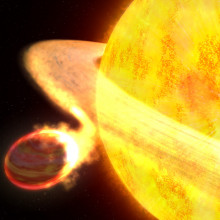
- How Massive can a Star be?
How Massive can a Star be?
New light on just how massive a star can become has been shed by a paper published this week in the Monthly Notices of the Royal Astronomical Society...
Stars come with a huge range of masses, ranging from the smallest brown dwarf stars, which have less than a tenth as much gas as our own Sun, to giant stars like Betelgeuse, with masses of twenty times that of the Sun.
But theorists who work on modelling the processes by which gas clouds can collapse down to form stars believe that there are hard limits to the lowest and highest masses that a star can have.
If a star has less than a twentieth the mass of the Sun, its core never becomes hot enough for to start nuclear fusion, the process which powers stars. What is formed resembles a gas giant planet like Jupiter, rather than a star that produces its own light.
At the opposite end of the mass spectrum, if a gas cloud has more than 150 times the mass of the Sun, it cannot gravitationally collapse to form a star. So much gravitational energy would be released in the process that the protostar would begin pulsating violently enough to rip the whole cloud apart.
However, a study in 2010 cast these theoretical models into some doubt. A group at the University of Bonn led by Sambaran Banerjee studied a star-forming region called the Tarantula Nebula, in a nearby dwarf galaxy called the Large Magellanic Cloud. Inside the region, they spotted four stars which they calculated to have masses of 400 times that of the Sun. This is over twice as large as the theoretical studies say it is possible to form.
But a follow-up paper, published by the same team in the Monthly Notices of the Royal Astronomical Society last week, finds that these stars may be easier to explain than previously thought. They built a computational model of the evolution of the Tarantula Nebula over time, modelling the way in which its stars move over time in each other's gravitational fields.
Because this is one of the most active star-forming regions in our Local Group of galaxies, Sambaran's team found that it was quite likely that some of its stars collide from time to time, subsequently merging to form more massive stars. Thus it is quite possible that, even if stars cannot form with masses over 150 solar masses, high mass stars can merge together later in life to form even more massive objects.
This is good news to the theorists who try to model star formation, who are no longer faced with the puzzle of explaining how to form stars that their models say should destroy themselves before they have time to form.
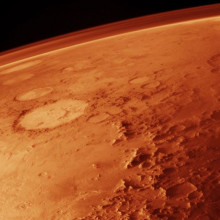
01:02 - Still Curious about Mars...
Still Curious about Mars...
with Fred Taylor, Emeritus Professor of Physics at Oxford University
We delve into the history of Mars exploration, finding out why the Red Planet has captured our imagination, and discovering the missions that led up to the Mars Science Laboratory...
Do telescopes only see back in time?
to follow
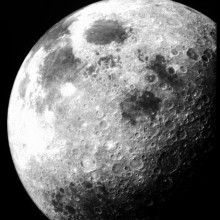
21:37 - Lunar X-Prize Heats Up
Lunar X-Prize Heats Up
This week, a team in Barcelona have announced that they have signed a launch service contract for a Chinese rocket to carry their lander to the moon.
The Barcelona Moon Team is taking part in the Lunar X-Prize, a Google-sponsored competition with an unprecedented $30 million payout for the winning team. The aim is to "stimulate innovation and create revolutions" by encouraging private missions to the moon, with the ultimate aim of creating frequent, inexpensive lunar trips, both for scientific and financial gain.
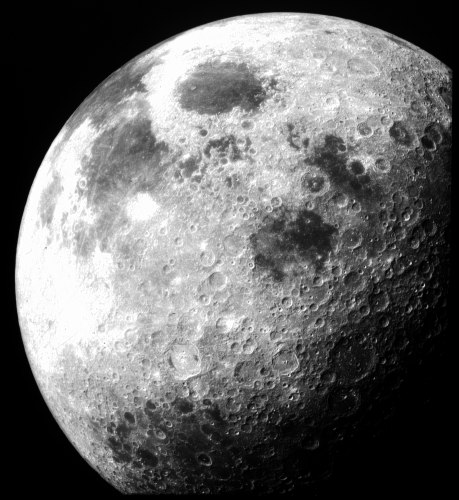 Registration closed back in December 2010, and there are now 26 teams from all over the globe who are in the process of designing, planning, testing and fundraising for their own lunar missions. To win the huge sum, they need to be the first team able to send a robot to the Moon that is capable of travelling at least 500 meters and transmitting video, images, and data back down to Earth. The runners-up will receive a smaller, but not insignificant, $5 million prize. The Spanish team have also designed an extra 25Kg payload capability, which they will offer to universities, commercial or pharmaceutical companies as an opportunity to see what access to the moon could do for them.
Registration closed back in December 2010, and there are now 26 teams from all over the globe who are in the process of designing, planning, testing and fundraising for their own lunar missions. To win the huge sum, they need to be the first team able to send a robot to the Moon that is capable of travelling at least 500 meters and transmitting video, images, and data back down to Earth. The runners-up will receive a smaller, but not insignificant, $5 million prize. The Spanish team have also designed an extra 25Kg payload capability, which they will offer to universities, commercial or pharmaceutical companies as an opportunity to see what access to the moon could do for them.
Interestingly, the organisers of the Lunar X-Prize actually expect that the teams may ultimately spend more than the prize money in order to achieve their goal. They point out that teams in previous competitions, such as the DARPA Challenges, have been known to spend as much as 5 times the prize value in order to complete the task.
The original space based X-prize - the Ansari X-Prize, was awarded to the Tier One project for launching a reusable space plane known as SpaceShipOne into space twice within two weeks. The technological and engineering challenges met by the team, and their solutions, are now going into the rapidly developing space-tourism business, and the competition itself inspired the current Lunar X-Prize.
The lunar x-prize hopes to do the same - both by solving technological problems and by inspiring and educating the next generation of scientists and engineers.
The Barcelona Moon Team's announcement shows that the competition is hotting up, and moving on to the next stage, setting themselves up as the head of the pack.
Look out Moon - here they come!
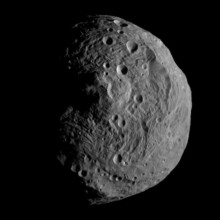
25:52 - Dawn's Departure & the Colour Changing Night Sky
Dawn's Departure & the Colour Changing Night Sky
with Dr Robert Massey, Royal Astronomical Society
In an update from the Royal Astronomical Society, we hear how Dawn, currently orbiting Vesta, will depart for a new asteroid this month, and how LED street lighting is changing the night sky...
35:57 - Why is Titan so squidgy?
Why is Titan so squidgy?
The Cassini spacecraft has made measurements of how much Saturn's moon Titan changes shape each time it circles Saturn, uncovering strong new evidence for liquid water beneath the moon's surface.
Writing in the journal Science, Luciano Iess and his colleagues measured how much Titan deforms on each orbit due to the tides it feels from Saturn's gravitation field - the fact that Saturn's gravitational field is stronger on the side facing its parent planet than on the far side.
Their paper models Titan as if it were an elastic ball that is compressed by these tides, and because Titan's orbit isn't perfectly circular, its distance from Saturn changes over the course of each orbit, and the degree of compression changes.
Using this to measure Titan's elasticity gives clues as to what the moon is made of and what lies beneath its surface. Crucially, Iess's team argues that the amplitude of the deformation is so large - around 10 metres - that Titan appears far more elastic than any known rock. That suggests the presence of a liquid layer beneath the surface which is able to flow on a global scale.
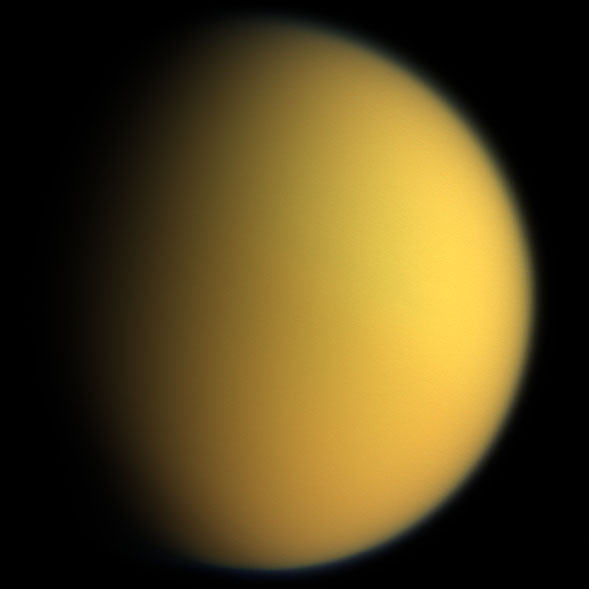 Speaking to me this week from the University of Rome where he is based, Iess explained the effect by using the Earth as a point of comparison.
Speaking to me this week from the University of Rome where he is based, Iess explained the effect by using the Earth as a point of comparison.
"In addition to the [Earth's] ocean tides, also the crust of the Earth deforms with tides which have an amplitude of around 40cm", he explains, adding that the deformation could only be this large because the Earth has liquid magma which is able to flow beneath its surface.
"If Titan were completely solid - made completely of rocks - it would not be deformed much. While we have seen tides that correspond to a deformation of around 10m, if Titan were completely solid, the deformation would have been maximum one metre".
His conclusion is that Titan too must have a liquid beneath its surface, and the measured elasticity is a good match to the viscosity and density of free-flowing liquid water.
These measurements are the culmination of data collected over several years. The Cassini spacecraft has been orbiting Saturn since 2004, and has made six close fly-bys of Titan in that time. Although the deformation of Titan's surface is too small to see in photographs, it produces tiny changes in Titan's gravitational field, which in turn affected how Cassini's trajectory was deflected by Titan on each close approach. Though these changes were tiny, the positions of spacecraft are routinely monitored to such high precision that even small forces changing their paths can be identified and measured.
One of the reasons why discoveries of liquid water elsewhere in the Solar System attract particular interest is that it is almost certainly necessary for life.
According to Iess, "The discovery of water does not imply life, but it's difficult to think of life without liquid water. Titan from the point of view of astrobiology is a very interesting object, because there are hydrocarbons, there is a cycle of liquids on the surface, there is liquid water: there are all of the ingredients which are necessary to build up life."
Looking ahead, he plans to refine his measurements over the next few years using three more fly-bys of Titan scheduled before Cassini is decommissioned in 2017.
There are also other moons in the Saturnian system that also warrant close inspection, in particular Enceladus. Although this is a very small moon just 200km across, geysers around its south pole provide strong evidence for pockets of liquid water beneath its surface, which may be probed by the next generation of spacecraft.
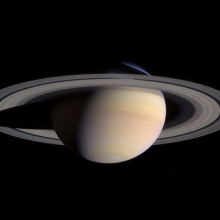
Why don't Saturn's rings aggregate to form moons?
Why don't Saturn's rings aggregate to form moons?
How much computing power does curiosity have?
How much computing power does curiosity have?
Does Curiosity use Nuclear Power to avoid Dusty Solar Panels?
Does Curiosity use Nuclear Power to avoid Dusty Solar Panels?
What can we expect next from Curiosity?
What can we expect next from Curiosity?
- Previous What is a Black Hole?
- Next Ptfe: Chemistry in its element










Comments
Add a comment